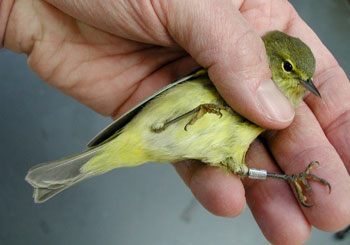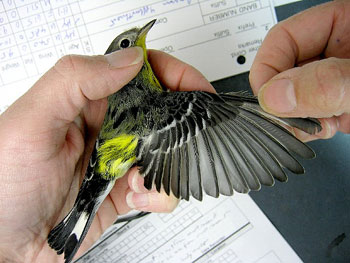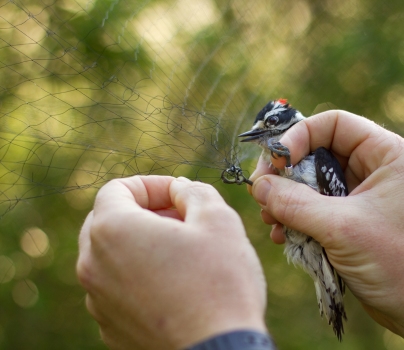 Banding Data
Banding Data
The Powdermill Avian Research Center (PARC) is leading the field in its development of a dynamic computer database of bird banding records. At the banding station, data from bird captures is entered directly into the database.
Researchers interested in fuller access to banding data should Contact PARC for more information.
Banding Station
PARC’s banding station is situated in a 10 hectare area of old fields, hedgerows, and marshy ponds, along with alder and willow-lined streams. The program area is bounded by an extensive mixed deciduous forest along Laurel Ridge to the east and by low intensity agricultural areas in the Ligonier Valley to the west.
Station researchers use up to 70 12-meter long, 2.5 meter high mist nets placed singly or in series of up to eight connected nets in hedgerow gaps and along habitat edges, mostly where adjacent vegetation is not much higher than the nets themselves. The locations for the mists nets have changed little over the course of 45 years.
To maintain the efficiency of the net locations for catching birds, habitat management is performed to remove tall woody vegetation from the vicinity of net lanes. Efforts to clear overgrown brush away from the pond banks and stream edges has opened up the wetland areas for more aerial foraging songbirds and to attract more wading birds.
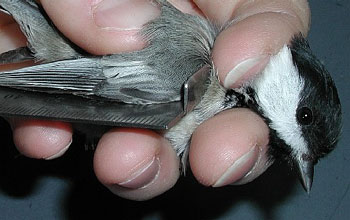 Bird Banding Protocol
Bird Banding Protocol
Above all else, the well being of every bird is our top priority at all times!
April through November, mist nets are opened before dawn each banding day. During winter months, banding operations are scaled back and plastic coated wire Potter traps baited with seed are used.
From the first deployment of the mist nets, about a half hour before sunrise, to the close of the banding day, nets are checked every 30 to 40 minutes as conditions allow. The nets themselves are designed for the safe capture of birds, large and small, and each bird is placed in a small drawstring bag for its trip to the banding station.
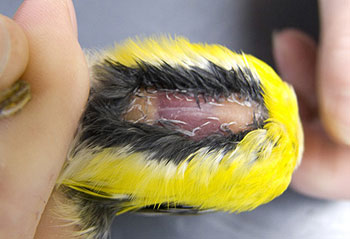 Once in the lab, birds are identified to species, banded (or reprocessed if they had been banded previously), and information about their age, sex, wing length, fat deposits, and body mass is recorded.
Once in the lab, birds are identified to species, banded (or reprocessed if they had been banded previously), and information about their age, sex, wing length, fat deposits, and body mass is recorded.
The band itself is a small information bracelet issued through the US Geological Survey. It causes no physical harm to the bird, nor does it impair flight, feeding, or any bird behavior.
The whole process of collecting data for each captured bird takes less than a minute, after which the bird is promptly released through a small sliding door in the window next to the banding desk.
While banding, weighing, and examining the birds may add a little stress to their day, no injuries are caused, and remember: many are migrating birds that will have traveled thousands of miles, faced enormous challenges, and have thousands of miles yet to go. The vast majority are actually quite calm during their short visit at the banding station.
Benefits of Bird Banding
The fundamental goal of bird banding has always been to record the age, sex, wing length, fat deposits, and body mass of captured species as a way of monitoring, year to year, how avian populations are faring in the wild. But bird banding research has many possible uses, including:
- Behavioral and Migratory Research
- Longevity and Life Cycles
- Prebasic Molt in Birds
- Weight and Plumage Changes
- Population Monitoring
- Habitat Use
- Disease and Environmental Toxins
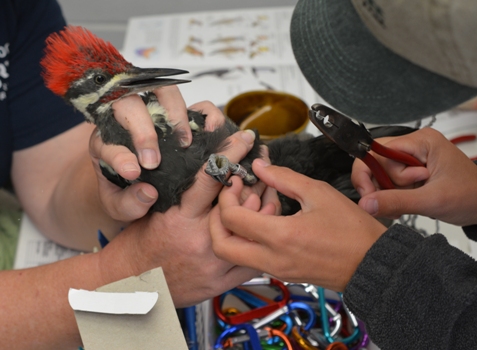
Ultimately, bird banding also helps us understand how to conserve the land and environments in which these migrating species live and breed.
Since it began full-time operation in 1962, PARC’s bird banding program has generated records at a rate of nearly 13,000 birds per year, with recaptures making up 20 percent, on average, of the annual total. By the end of 2005, the program’s database included records from just under 460,000 original bandings and over 110,000 recaptures, representing 190 species.
PARC banding records are submitted regularly to the Bird Banding Laboratory, which maintains the bird-banding database for all of North America.

